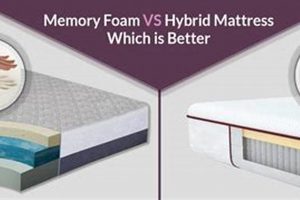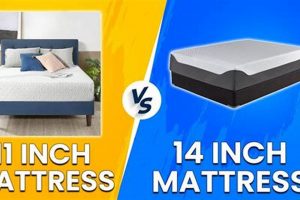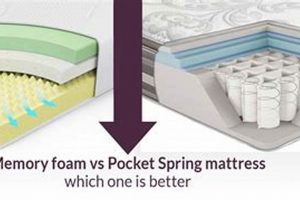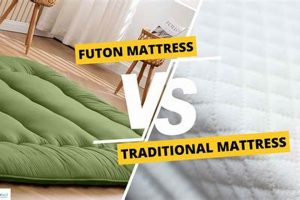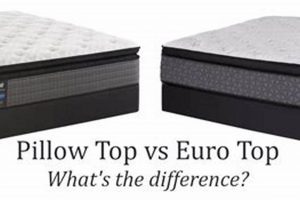A bedding item designed to enhance comfort is distinct from one primarily intended to safeguard against spills and wear. The former often features a thicker construction, incorporating materials like memory foam or down alternatives to alter the feel of the sleep surface. The latter provides a thin, often waterproof, barrier between the mattress and potential damage, maintaining the original mattress feel.
Preserving the lifespan of a significant investment and optimizing sleep quality are key objectives in bedding maintenance. Throughout history, various materials and designs have been employed to protect mattresses from stains, allergens, and general deterioration. This evolution reflects a growing awareness of the impact of sleep environment on overall well-being.
The subsequent discussion will delve into the specific features, benefits, and drawbacks of each type of bedding accessory, providing a detailed comparison to aid informed consumer decisions regarding comfort and protection needs.
Key Considerations
This section presents essential guidelines for selecting the appropriate bedding accessory to meet specific needs regarding comfort, hygiene, and mattress longevity.
Tip 1: Evaluate Primary Need: Determine if the primary objective is to alter the firmness or feel of the mattress, or to shield it from liquids, allergens, or pests. This assessment will guide the selection process significantly.
Tip 2: Assess Material Composition: Scrutinize the materials used in construction. Options range from natural fibers like cotton to synthetic blends incorporating memory foam or waterproof membranes. Each material offers distinct properties regarding breathability, comfort, and protection levels.
Tip 3: Consider Waterproofing Requirements: For individuals with children, pets, or concerns about spills, a waterproof layer is crucial. Ensure the waterproofing material is breathable to avoid overheating during sleep.
Tip 4: Examine Fit and Security: Confirm that the selected item fits the mattress snugly and securely. Loose fitting accessories can shift during sleep, compromising comfort and protection.
Tip 5: Review Cleaning and Maintenance Instructions: Understand the care requirements before purchase. Some materials are machine washable, while others require professional cleaning. Adherence to care instructions extends the lifespan of the product.
Tip 6: Analyze Warranty Information: Check the manufacturer’s warranty. This provides assurance against defects in materials or workmanship and can inform the perceived quality of the item.
Proper selection and maintenance ensure both a comfortable sleep environment and the preservation of the mattress investment. Careful consideration of these guidelines will assist in making an informed decision.
The following section will conclude the discussion, summarizing the core distinctions and recommending optimal use cases.
1. Comfort Enhancement
Comfort enhancement, a primary consideration in bedding selection, differentiates these items based on their intended impact on the sleep surface’s feel and support. While both contribute to hygiene, the degree to which they modify comfort varies significantly.
- Material Composition and Loft
Pads frequently incorporate materials such as memory foam, down alternatives, or fiberfill to add cushioning and alter the firmness. The loft, or thickness, of the pad directly affects the degree of comfort modification. Protectors, conversely, are designed to be thin and unobtrusive, minimally impacting the original mattress feel.
- Pressure Point Relief
Pads with substantial cushioning can alleviate pressure points, potentially improving sleep quality for individuals experiencing discomfort. A protector, while preventing allergens and liquids from penetrating the mattress, offers little to no pressure relief.
- Temperature Regulation
Some pads utilize materials designed to regulate temperature, such as cooling gels or breathable fabrics. Protectors may also incorporate temperature-regulating technologies, but their primary function remains protection rather than enhanced comfort through temperature control.
- Support and Alignment
While neither item fundamentally alters the support of a mattress core, a thicker pad may provide a subtle improvement in spinal alignment by creating a more even sleep surface, particularly on older or slightly sagging mattresses. Protectors offer no such supportive benefit.
In summary, when prioritizing a discernible change in the sleep surface’s comfort level, a pad is generally the more suitable choice. If the primary objective is maintaining the original mattress feel while providing a hygienic barrier, a protector is more appropriate.
2. Liquid Barrier
The capacity to act as a liquid barrier is a critical distinction when evaluating bedding accessories. This functionality directly impacts mattress longevity, hygiene, and overall sleep environment quality.
- Waterproof Membrane Integration
Many protectors incorporate a waterproof membrane, typically made of polyurethane or a similar material, to prevent liquid penetration. This membrane forms an impermeable barrier, safeguarding the mattress from spills, sweat, and other fluids. Pads may or may not include a waterproof layer; those designed for comfort enhancement often lack this feature, prioritizing breathability over liquid resistance. Instances where liquid protection is not needed, such as dry climate, may prefer breathable pad.
- Seam Construction and Integrity
The effectiveness of a liquid barrier is directly related to the construction of seams and edges. Protectors with reinforced seams and tightly sealed edges minimize the risk of liquid seeping through vulnerable points. Pads, particularly those with quilted designs or multiple layers, may present more potential entry points for liquids if not specifically designed with waterproof construction. The quality of seam is critical to prevent liquid damage for both.
- Breathability Considerations
A completely impermeable liquid barrier can restrict airflow, potentially leading to heat buildup and discomfort during sleep. High-quality protectors often employ breathable waterproof membranes, allowing moisture vapor to escape while preventing liquid penetration. Pads lacking waterproof features are inherently more breathable but offer no liquid protection. Balances needs to be set between liquid barrier and comfort.
- Maintenance and Cleaning Protocols
Liquid barrier capabilities influence cleaning requirements. Protectors with waterproof membranes can typically be wiped clean or machine washed to remove spills and stains. Pads, depending on their construction and materials, may require professional cleaning or spot treatment, particularly if they lack waterproof features. Regular maintenance is key to ensure mattress protection.
These factors collectively determine the effectiveness of bedding accessories as liquid barriers. The choice between a protector prioritizing waterproofing and a pad focusing on comfort depends on the specific needs and risk factors associated with liquid exposure within the sleep environment, influencing the selection criteria between a pad or protector.
3. Thickness Variation
Thickness variation constitutes a primary differentiating factor between a mattress pad and a mattress protector, influencing their respective functionalities and suitability for specific sleep needs. This characteristic affects comfort, protection, and overall sleep experience. A protector is typically designed to be thin, often less than a quarter of an inch, with the primary function of creating a barrier against liquids, allergens, and bed bugs. The thin profile ensures minimal alteration to the mattress’s original feel. In contrast, a pad aims to enhance comfort through added cushioning, and therefore exhibits a greater thickness, ranging from half an inch to several inches, depending on the fill material and construction. For example, a memory foam pad will be significantly thicker than a basic quilted protector.
The practical significance of thickness variation is evident in various scenarios. Individuals seeking to soften a firm mattress may opt for a thicker pad with a plush filling. Conversely, those satisfied with their mattress’s comfort level but concerned about spills or allergens would likely choose a thin protector. Hospitals commonly utilize thin, waterproof protectors for hygiene, whereas home users might prioritize thicker pads for enhanced sleep surface comfort. This difference highlights the practical application of understanding the interplay between thickness and intended purpose. The material used also contributes to these features; cotton may offer a breathable thinner option, whereas a waterproof layer may be slightly thicker.
In summary, thickness variation serves as a key determinant when distinguishing between bedding accessories. The choice between a thin, protective layer and a thicker, comfort-enhancing pad hinges on individual priorities and existing mattress characteristics. Understanding this distinction allows for informed decisions that optimize both sleep quality and mattress longevity. There can be challenges of the impact thickness can have on sheets fitting properly and ease of storing the protectors or pads. The understanding of how to pair your bedding to maximize effectiveness depends on being able to differentiate between these aspects of thickness variation.
4. Mattress Protection
Mattress protection is a fundamental consideration in maintaining the longevity and hygiene of sleep surfaces, directly influencing the selection between a mattress pad and a mattress protector. The primary objective is to shield the mattress from various sources of damage and contamination, thereby preserving its integrity and promoting a healthier sleep environment. This necessitates understanding the distinct roles and capabilities of each bedding accessory.
- Barrier Against Liquids and Stains
Liquid spills and stains are significant threats to mattress integrity, potentially leading to irreversible damage and fostering microbial growth. Mattress protectors, particularly those with waterproof membranes, provide an effective barrier against these hazards, preventing liquids from penetrating the mattress core. Mattress pads may offer some degree of stain resistance but are generally less effective in preventing liquid penetration, unless specifically designed with waterproof features. The absence of such protection can result in costly mattress replacement.
- Allergen and Dust Mite Control
Mattresses can harbor allergens and dust mites, exacerbating respiratory issues and allergies. Mattress protectors create a barrier that reduces the accumulation of these allergens within the mattress, promoting a cleaner sleep environment. While mattress pads can offer a degree of allergen reduction through their fabric composition, they are less effective at preventing allergen penetration than tightly woven protectors. Regular washing of protectors further minimizes allergen buildup.
- Protection Against Wear and Tear
Daily use contributes to wear and tear on the mattress surface, reducing its lifespan and comfort. Mattress protectors act as a buffer, shielding the mattress from friction and abrasion. Mattress pads, while offering some cushioning, may not provide the same level of protection against physical wear. The extended lifespan of a protected mattress represents a significant economic benefit.
- Bed Bug Prevention
Mattress protectors can play a crucial role in preventing bed bug infestations by creating a physical barrier that denies these pests access to the mattress interior. Encasement-style protectors, which fully enclose the mattress, are particularly effective. While mattress pads can offer a degree of protection, they typically do not provide the same level of comprehensive coverage as a dedicated bed bug protector. The reduction of potential infestation risks justifies the use of protectors.
Collectively, these facets underscore the importance of mattress protection as a primary driver in the selection process. Whether prioritizing comprehensive protection against liquids, allergens, wear and tear, or pests, the choice between a pad and a protector hinges on the specific protection needs and the desired level of safeguard against potential damage. Prioritizing mattress protection helps improve mattress longevity and sleep hygiene.
5. Material Composition
The composition of materials significantly dictates the performance characteristics and suitability of bedding accessories. This consideration is paramount when differentiating between a mattress pad and a mattress protector, as the chosen materials directly impact comfort, protection, and overall durability.
- Core Materials and Their Impact on Comfort
Mattress pads often incorporate materials such as memory foam, latex, down alternatives (e.g., polyester fiberfill), or cotton batting to enhance sleep surface comfort. Memory foam conforms to the body, providing pressure relief. Latex offers resilient support and breathability. Down alternatives provide a soft, plush feel. The selection of core material directly influences the pad’s ability to alter the firmness and contouring of the mattress. Protectors, in contrast, typically utilize thinner, less substantial materials like cotton, polyester blends, or microfiber to maintain a low profile and minimize impact on the mattress feel.
- Protective Layer Materials and Waterproofing
A primary function of mattress protectors is to provide a barrier against liquids, allergens, and dust mites. This is typically achieved through the integration of a waterproof membrane, often made of polyurethane or thermoplastic polyurethane (TPU). These materials prevent liquid penetration while allowing some degree of breathability. The quality and breathability of the waterproof layer are crucial factors influencing sleep comfort and hygiene. Some pads incorporate waterproofing but often compromise comfort to do so.
- Surface Fabric and its Influence on Breathability and Feel
The surface fabric, or ticking, of both pads and protectors plays a crucial role in breathability, moisture wicking, and overall feel. Common surface fabrics include cotton, bamboo, rayon, and polyester. Natural fibers like cotton and bamboo offer enhanced breathability and moisture absorption compared to synthetic fibers. The weave and finish of the fabric also influence its texture and durability. A tightly woven fabric can enhance allergen resistance.
- Construction Techniques and Material Interaction
The way materials are combined and constructed significantly impacts performance. Quilted construction distributes fill evenly in pads. Elasticized edges or anchor bands secure the pad or protector to the mattress. Laminated layers create waterproof barriers. The interaction of different materials within a single product determines its overall effectiveness and longevity. For example, a protector with a breathable cotton surface and a waterproof TPU membrane offers a balance of comfort and protection.
In conclusion, the material composition of a mattress pad versus a mattress protector is a critical determinant of its functionality. The choice of materials should align with the primary objective: enhancing comfort, providing protection, or achieving a balance between the two. A thorough understanding of material properties and construction techniques is essential for making an informed decision.
6. Cleaning Ease
Cleaning ease represents a significant practical consideration in the selection of bedding accessories, directly impacting maintenance costs, hygiene levels, and the overall lifespan of both the accessory and the underlying mattress. The distinct construction and material composition of mattress pads and protectors dictate their respective cleaning protocols and the level of effort required for upkeep.
- Washability and Drying Requirements
Mattress protectors are typically designed for frequent laundering, often being machine washable and dryer-safe. This allows for regular removal of allergens, dust mites, and surface stains. Mattress pads, particularly those with bulky fill materials like memory foam or down alternatives, may present greater challenges in terms of washability and drying. Some pads require spot cleaning or professional laundering due to their size and delicate components. The convenience of machine washability is a key factor for many consumers. Improper cleaning can degrade the protective qualities of either.
- Stain Resistance and Removal
The surface fabric of both pads and protectors influences stain resistance. Tightly woven fabrics and stain-resistant finishes can simplify stain removal. Protectors with waterproof membranes prevent liquids from penetrating the material, making cleanup easier. Pads, especially those lacking a protective layer, may be more susceptible to staining, requiring specialized cleaning products or techniques. Prompt stain removal is essential to prevent permanent discoloration.
- Frequency of Cleaning and Maintenance
Mattress protectors, due to their direct contact with the sleeper and their role as a barrier against contaminants, benefit from more frequent cleaning than mattress pads. Regular washing, typically every one to two months, helps maintain hygiene and allergen control. Mattress pads, unless soiled, may require less frequent cleaning, perhaps every three to six months. Adhering to manufacturer’s cleaning instructions is crucial for preserving the integrity and performance of both items. Neglecting cleaning will impact lifespan of either item.
- Material-Specific Cleaning Considerations
Different materials require specific cleaning approaches. Cotton and polyester protectors can generally withstand standard washing cycles. Memory foam pads may require gentle cleaning with mild detergents to avoid damaging the foam. Waterproof membranes should be cleaned with care to prevent delamination or cracking. Failure to follow material-specific cleaning guidelines can compromise the functionality and longevity of the bedding accessory.
In summary, cleaning ease is a practical consideration that differentiates mattress pads and protectors. The ease with which these items can be cleaned, the frequency of required cleaning, and the specific cleaning protocols associated with their material composition all influence their suitability for different users and lifestyles. Prioritizing cleaning ease can reduce long-term maintenance costs and promote a healthier sleep environment, requiring an active consideration during purchase.
7. Cost Implications
The financial aspects associated with bedding accessories are a salient consideration when evaluating mattress pads and mattress protectors. Initial purchase price, replacement frequency, and the potential to extend the mattress lifespan contribute to the overall cost implications. Mattress protectors generally exhibit a lower initial cost compared to pads, attributable to their simpler construction and less substantial material composition. Protectors primarily serve a protective function, minimizing the need for premium materials often incorporated into pads for enhanced comfort. However, the long-term cost-effectiveness depends on the frequency of replacement and the degree to which the protector prevents damage to the underlying mattress. For example, a quality protector, preventing a single major spill, can avert the far greater expense of mattress replacement.
The lifespan of both mattress pads and protectors is influenced by factors such as material quality, construction, and cleaning practices. Lower-cost options may exhibit premature wear and tear, necessitating more frequent replacements, thereby offsetting any initial savings. Conversely, higher-quality pads and protectors, while representing a larger upfront investment, may offer greater durability and longevity, resulting in lower long-term costs. Furthermore, the use of a protector can indirectly reduce expenses by mitigating the need for professional mattress cleaning or, as previously noted, complete replacement due to irreparable damage. For instance, opting for a mid-range protector with a waterproof membrane could prevent a costly pet-related accident from ruining the mattress.
In summary, a comprehensive assessment of cost implications requires consideration beyond the initial purchase price. Factors such as material quality, durability, cleaning requirements, and the potential to protect the mattress from damage must be weighed. While mattress protectors generally present a lower upfront cost, the long-term economic benefits of both pads and protectors depend on their ability to preserve the mattress and provide a comfortable, hygienic sleep environment. The value proposition lies in strategically balancing initial investment with projected lifespan and protective capabilities, aligning with individual needs and financial constraints. Ultimately, an informed decision requires evaluating not just the price tag, but the total cost of ownership.
Frequently Asked Questions
This section addresses common inquiries regarding the functional differences and appropriate applications of bedding accessories. Clarity on these points can inform optimal product selection.
Question 1: What is the fundamental distinction between a mattress pad and a mattress protector?
A mattress pad primarily enhances comfort through added cushioning, while a mattress protector focuses on safeguarding the mattress against liquids, allergens, and physical wear. One prioritizes sleep surface modification, the other preservation.
Question 2: Is a waterproof mattress protector necessary for all mattresses?
A waterproof mattress protector is advisable for mattresses susceptible to spills, such as those in households with children, pets, or individuals prone to nighttime accidents. However, for individuals without these risk factors, a non-waterproof protector may suffice for basic hygiene.
Question 3: Can a mattress pad adequately protect a mattress from bed bugs?
A standard mattress pad offers limited protection against bed bugs. For effective bed bug prevention, an encasement-style mattress protector that fully encloses the mattress is recommended. Such protectors deny bed bugs access to the mattress interior.
Question 4: How often should a mattress protector be cleaned?
A mattress protector should be laundered every one to two months, or more frequently if soiled. Regular cleaning removes allergens, dust mites, and surface stains, promoting a hygienic sleep environment.
Question 5: Does the thickness of a mattress pad directly correlate with its comfort level?
While thickness contributes to comfort, the material composition of the mattress pad is equally important. A pad with high-quality fill, such as memory foam or down alternatives, will generally provide greater comfort than a thicker pad with inferior materials.
Question 6: Can a mattress protector alter the feel of the mattress?
A thin mattress protector typically has minimal impact on the mattress feel. However, thicker protectors, particularly those with quilted surfaces, may slightly alter the firmness or contouring of the sleep surface.
The preceding clarifications should facilitate informed decisions when selecting bedding accessories. A thorough understanding of individual needs and product attributes is essential for optimizing both sleep comfort and mattress longevity.
The following section will provide a summary of this dicussion.
mattress pad vs mattress protector
This exploration has illuminated the critical distinctions between a mattress pad and a mattress protector. While both contribute to the sleep environment, their primary functions differ significantly. The mattress pad serves predominantly to enhance comfort through added cushioning and support, potentially altering the feel of the sleep surface. Conversely, the mattress protector is primarily designed to safeguard the mattress against liquids, allergens, and physical wear, preserving its integrity and prolonging its lifespan. Key considerations include material composition, thickness variation, liquid barrier capabilities, cleaning ease, and cost implications.
The informed selection of bedding accessories necessitates a careful evaluation of individual needs and priorities. Understanding the nuanced differences between a mattress pad and a mattress protector empowers consumers to make strategic decisions that optimize both sleep quality and the long-term value of their mattress investment. A proactive approach to bedding maintenance, guided by a clear understanding of these distinctions, is essential for promoting a healthy and restful sleep environment.


